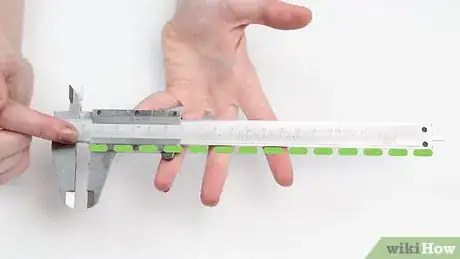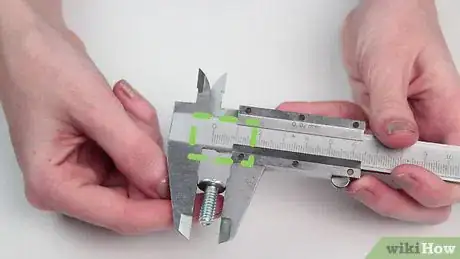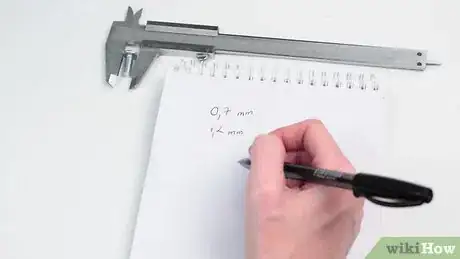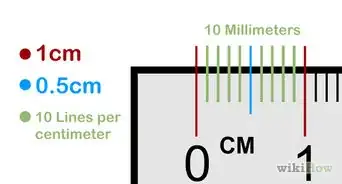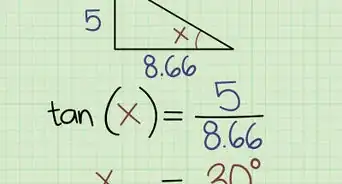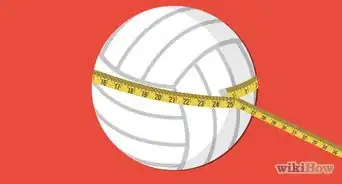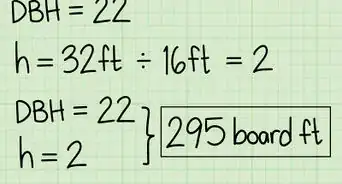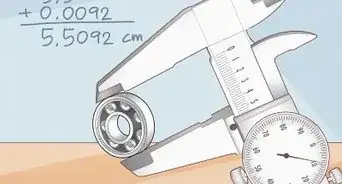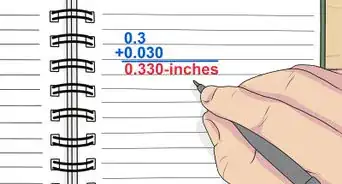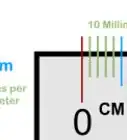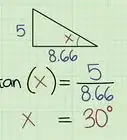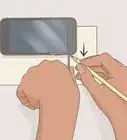This article was co-authored by wikiHow Staff. Our trained team of editors and researchers validate articles for accuracy and comprehensiveness. wikiHow's Content Management Team carefully monitors the work from our editorial staff to ensure that each article is backed by trusted research and meets our high quality standards.
wikiHow marks an article as reader-approved once it receives enough positive feedback. This article has 31 testimonials from our readers, earning it our reader-approved status.
This article has been viewed 1,869,059 times.
Learn more...
A Vernier caliper is an instrument that measures internal or external dimensions and distances. It allows you to take more precise measurements than you could with regular rulers. This wikiHow will show you how to use and read a Vernier caliper.
Things You Should Know
- Examine your caliper to see how much distance goes between each notch.
- Calibrate your caliper before using it by closing the jaws.
- Place the item you'd like to measure in between the caliper jaws.
- Read both the main scale and the Vernier scale to get a complete measurement.
Steps
Preparing Your Instruments and Tools
-
1Understand the parts of the Vernier caliper. A Vernier caliper has main jaws that are used for measuring external diameter, as well as smaller jaws that are used for measuring the internal diameter of objects. Some models also have a depth gauge. The main scale is fixed in place, while the Vernier scale is the name for the sliding scale that opens and closes the jaws.[1]
-
2Read the scales on your Vernier caliper. Each scale of your caliper reads like an ordinary ruler. Typically, a caliper has a main scale marked with numbered inches or centimeters, plus smaller divisions between them. The sliding (Vernier) scale should have a label engraved on it to tell you what it represents.[2]
- If the sliding scale doesn't have a label, you can assume the numbered divisions represent 1/10 of the smallest division on the main scale. For example, if the main scale's smallest lines represent 0.1 inches, then each numbered division on the Vernier scale represents 0.01 inches.
- The main scale is "life size," while the sliding scale is magnified for easy reading. This magnification system allows the Vernier caliper to measure more precisely than a ruler.
Advertisement -
3Check the scale of your smallest divisions. Before making a measurement, count the number of lines between two numbers on your Vernier scale. Use this to determine how much distance each of the smallest lines represents.[3]
- For example, the numbers on a Vernier scale represent 0.1 inches, and there are five unnumbered lines between them. 0.1 inches ÷ 5 = 0.02 inches, so each of the unnumbered lines represents 0.02 inches.
-
4Clean the object you are measuring. Wipe it off to make sure there’s no grease on it, and that there’s nothing in the way that will interfere with an accurate measurement.
-
5Unlock the screw. If your Vernier caliper has a locking screw, loosen it before you begin.
- Twisting something to the right (clockwise) will tighten it, while twisting it to the left (counter clockwise) will loosen it.
-
6Close the jaws. Before measuring anything, close the jaws and faces to zero out the reading so that you get a precise measurement. If you don’t do this, you won’t start with your scales lined up at zero when you take your measurement, and you will have to correct for the zero error.[4]
- For example, if the zero on the sliding scale lines up with 1 mm on the fixed scale, you have a positive zero error of +1 mm. Subtract 1 mm from all measurements to get the right result.
- If the zero on the sliding scale is to the left of the main scale zero, you have a negative zero error. Slide it so the zeros line up, while watching another mark to see the size of the error. For example, if the 0.5mm mark moves from the 1mm mark to about the 2.1 mm position, the zero error is -(2.1 - 1), or -1.1 mm. Add 1.1 mm to all measurements to correct this.
Using the Caliper
-
1Slide one of the jaws against the object. The caliper has two types of jaws. The larger ones tighten around an object, to measure the distance across it. The smaller jaws fit into an opening, and can then be pushed outward to measure its internal diameter. You can adjust either pair of jaws by sliding the smaller scale. Once you've got one of the jaws in position, tighten the locking screw if there is one.[5]
-
2Read the main scale where it lines up with the sliding scale's zero. The main scale on a Vernier caliper typically tells you the whole number plus the first decimal. Read this just as you would a ruler, measuring to the zero mark on the sliding (Vernier) scale.
- For example, if the 0 on the sliding scale lines up with the 2 inch mark, your measurement is 2 inches. If it lines up past 2 inches by six tenth-inch marks, your measurement is 2.6 inches.
- If the result is between two lines, just use the smaller value. Do not try to estimate a value between the two lines.
-
3Read the Vernier scale. Find the first mark on the Vernier scale that lines up perfectly with any line on the main scale. That mark tells you the value of the additional digits.[6]
- For example, the 14 on the Vernier scale aligns with a line on the main scale. Let's say the scale represents 0.01 inch increments, so the 14 represents 0.014".
- It makes no difference which line on the main scale it aligns with. We've already taken our reading from the main scale; don't take another one.
-
4Add the numbers together. Add the main scale and Vernier scale results together to get the final answer. Make sure you use the correct units as labeled on each scale, or you won't get the right answer.
- In our example, we measured 2.6 inches on the main scale, and 0.014 inches on the Vernier scale. Our final measurement is 2.614 inches.
- The digits don't always line up this neatly. For example, if the main centimeter scale reads 0.85, and the Vernier 0.01 cm scale reads 12, adding them together results in 0.85 + 0.012 = 0.862 cm.
Community Q&A
-
QuestionHow do I find the least count?
 Community AnswerLeast count is the ratio of the smallest division of the main scale to the number of divisions on the vernier scale.
Community AnswerLeast count is the ratio of the smallest division of the main scale to the number of divisions on the vernier scale. -
QuestionHow do you find the measurement of the vernier scale?
 Community AnswerFor measuring length, compare the 0 line of the Vernier scale with the main scale. Then check the division that coincides with the main scale. Then add the first reading with the third reading by multiplying.
Community AnswerFor measuring length, compare the 0 line of the Vernier scale with the main scale. Then check the division that coincides with the main scale. Then add the first reading with the third reading by multiplying. -
QuestionWhat are the applications of Vernier caliphs in everyday life?
 Community AnswerThey can be used in the repair or creation of anything that needs a tight tolerance. These instruments are commonly used in scientific and industrial fields.
Community AnswerThey can be used in the repair or creation of anything that needs a tight tolerance. These instruments are commonly used in scientific and industrial fields.
References
- ↑ http://www.physics.smu.edu/~scalise/apparatus/caliper/
- ↑ https://www.miniphysics.com/how-to-read-a-vernier-caliper.html
- ↑ http://www.geol.lsu.edu/jlorenzo/geophysics/VernierCaliper/caliper.html
- ↑ https://www.physics.smu.edu/~scalise/apparatus/caliper/
- ↑ http://www.phy.uct.ac.za/courses/phylab1/vernier
- ↑ http://science.clemson.edu/physics/labs/labs/cupol/vernier/index.html
About This Article
To use a Vernier caliper, start by twisting the locking screw counterclockwise to loosen it. Then, close the jaws of the instrument all the way so you start with your scales lined up at zero. Next, open the jaws and insert an object between them, closing the jaws around it to hold it in place. Once the jaws are closed around the object, look at the number on the main scale that lines up with the sliding scale's zero. Then, find the mark on the Vernier scale that lines up with a number on the main scale. Finally, add those two numbers together to get your measurement. To learn how to read the different scales on a Vernier caliper, keep reading!

